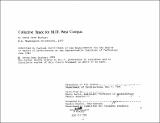Collective space for M.I.T. West Campus
Author(s)
Barbaro, Donna Anne
DownloadFull printable version (10.42Mb)
Alternative title
Collective space for MIT West Campus
Collective space for Massachusetts Institute of Technology West Campus
Other Contributors
Massachusetts Institute of Technology. Dept. of Architecture.
Advisor
Barry Zevin.
Terms of use
Metadata
Show full item recordAbstract
The vitality felt in proceeding through a marketplace or in walking through the streets of some towns and cities can sensitize one to the particular potential a street can have as a place for informal conversation, sitting, watching or gathering collectively - an alternative setting to the social atmosphere that exists within offices or classrooms. The range of outdoor spaces that can be found are organized according to principles which people have agreed upon formally or informally over time. Streets with this level of definition are easy to stay in, move ones' chair or wares out into or carry on 'with business' in. Although passage through is often its most important function, a successful street also offers a clarity of territorial definition with 'eddies,' boundaries and backs that allow a range of other activities to occur. In its best sense, one could feel that one is moving through a collection of outdoor rooms of various enclosure, each related in some sense to both the public path and to the less public spaces beyond. On a university campus, where exposure and discourse are encouraged, a collective backbone of this nature would be an asset, both as an outlet within the university and as a way of tying the university to the surrounding community. The intention of this thesis is two-fold; first to explore street as place and "linkage" in the context of site and building edge; and second, to suggest alternatives for the MIT West Campus.
Description
Thesis (M. Arch.)--Massachusetts Institute of Technology, Dept. of Architecture, 1981. MICROFICHE COPY AVAILABLE IN ARCHIVES AND ROTCH. Includes bibliographical references (p. 79-81).
Date issued
1981Department
Massachusetts Institute of Technology. Department of ArchitecturePublisher
Massachusetts Institute of Technology
Keywords
Architecture.